Chef’s knives, utility knives, paring knives, bread knives, slicers, and even tomato knives.
There is a laundry list of types of kitchen knives, which might confuse even some of the most enthusiastic home chefs.
Fortunately, we have rounded up this article on the most popular kitchen knives and their intended uses.
We have added a list of 4 essential kitchen knives in a home kitchen so that you know where to start when gearing up your kitchen or simply trying to trim down your kitchen equipment to the bare essentials.
But before diving into the many types of kitchen knives and what they do, let’s take a brief look at knife blades and their pros and cons.
Knife Blades: Overview
The three most popular types of blades you’ll likely find in a kitchen knife are:
1) High Carbon Steel
2) Stainless steel
3) Ceramic
Each of these materials have their pros, and we cannot say that one is definitely the best.
But each one of them also has its tradeoffs, so when you are shopping around for a quality chef’s knife or any other type of knife keep in mind both their pros and cons.
1) High Carbon Steel Kitchen Knives
As its name suggests, it is a type of steel that has been enriched with carbon to make it tougher and hold a sharp edge longer.
Carbon steel knives are some of the sharpest and toughest knives out there and the favorite tool of many seasoned cooks.
Pros:
- HC steel holds an edge better than stainless steel or ceramic
- Is tougher than stainless/ceramic
- Is the no.1 choice of serious cooks
Cons:
- Maintenance of carbon steel knives can be a hassle
- Rusts and stains more easily than stainless/ ceramic
- Pricey
2) Stainless Steel Kitchen Knives
Stainless Steel is a type of steel that has been enriched with chromium (up to 12%) to make it corrosion- and rust-free.
This means that it won’t rust if left lying in pooling water or too close to the stove (where water and other liquids tend to evaporate).
Plus, it won’t need special care, as carbon steel does.
However, the perks end here.
Stainless steel knives’ Achilles’ heel is their soft blade, which tends to get out of shape faster than a carbon steel one.
Nevertheless, due to the convenience, stainless steel is preferred by most home cooks.
Pros:
- Rust-resistant
- Low-maintenance
- Inexpensive
Cons:
- The blade loses edge fast with intense use
- Harder to sharpen than carbon steel, according to the pros
3) Ceramic Kitchen Knives
Ceramic has been around for more than two decades and, ever since their release, ceramic knives have gained rapid traction due to their many advantages over their steel-blade counterparts. But despite their awesome looks and feel, there are some downsides that might outweigh the benefits.
Pros:
- Ceramic does not react with acidic foods
- Dishwasher safe
- Lightweight
- Won’t release nasty particles into food
Cons:
- Poor edge retention, despite what the marketing people might tell you
- Ceramic is very brittle (ceramic blades easily break or chip unless you care for them)
- Sharpening is iffy (see the con above)
- Pricey
The Many Types of Kitchen Knives and their Uses
We’ll now break down the various types of kitchen knives into three categories based on their normal use in a home kitchen:
1. Must-haves kitchen knives of every home cook.
- The Chef’s knife
- The Bread knife
- The Paring knife
- The Serrated utility knife
2. The-Can-Live-Without-but-Would-Be-Nice-to-Have Kitchen Knives
- The Santoku
- The Slicer
- The Boning/ Fillet knife
- The Carving knife
3. The Can-Go-Without’s
- The Meat cleaver
- The Steak knife
- The Carving knife
- Kitchen shears
Must-Have Kitchen Knives for Every Home Cook
1. The chef’s knife
The Chef’s knife is a general-purpose kitchen knife that should carry out most kitchen tasks on its own.
Because you would be using this for just about anything in the kitchen, we recommend saving money and investing in a quality chef’s knife.
Get an 8” or 10” knife (or even 6” if you have small hands).
Here are our personal favorites:
Global Chef’s knife
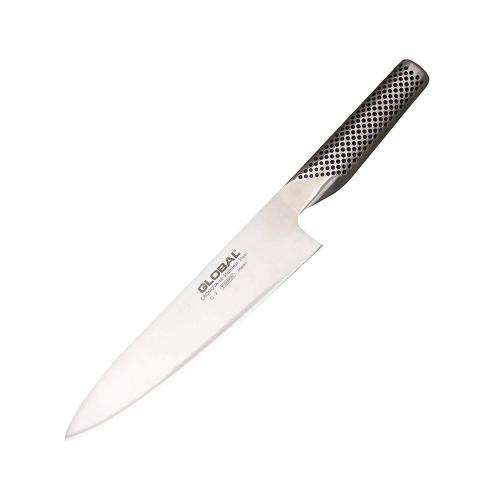
Global kitchen knives are known for their outstanding sharpness right out of the box and premium quality. You can’t go wrong with a Global.
DALSTRONG Chef’s Knife

This knife by Dalstrong is a Japanese-style chef’s knife also known as a Gyuto, with a very tough blade and ergonomic handle. It makes a perfect gift for whatever occasion requires one.
Victorinox 10 Inch Fibrox Pro Chef’s Knife
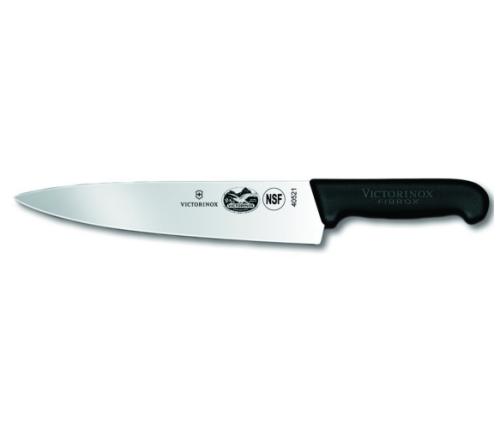
If you are on a budget or simply gearing up your kitchen from scratch, the Victorinox Fibrox Pro Chef’s Knife is all you need. It is a very versatile chef’s knife, with a quality build that will impress even some of the pickiest cooks.
2. The Bread Knife
is also a must-have if you routinely eat bread or have many guests over. But you could replace this one with a very sharp chef’s or slicing knife.
A bread knife is ideal for cutting through foods with a hard shell and soft interior that might get damaged in the process, such as bread, sausages, some types of cheese, peaches, tomatoes, sandwiches, and more.
Here is our top pick:
Wustoff bread knife
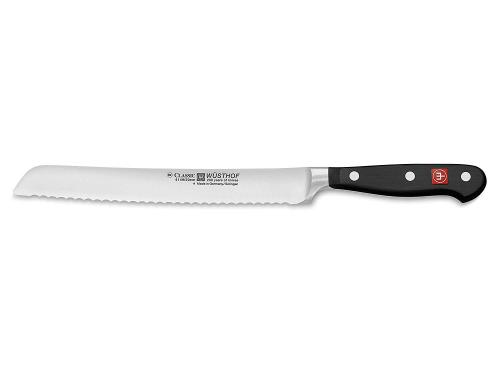
Also, if you are not that much into bread, you can buy the less-known cousin of the bread knife, the tomato knife. This oddly-shaped knife sports a serrated blade and (sometimes) tongs and it is best used for dealing with tomatoes and sausages for keeping your hands clean while you’re at it.
As for a tomato knife, our personal favorite is:
DALSTRONG Tomato Slicer Knife
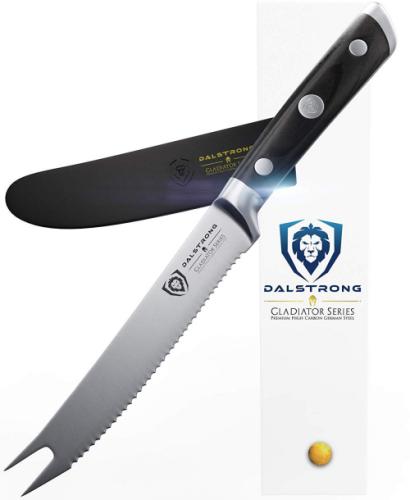
This one is a bit of investment, but well worth it.
3. The paring knife
The paring is a universal knife used for things that are too small for a chef’s knife to handle.
You should be using a paring knife whenever you need to remove stems from tomatoes or strawberries, core apples, devein shrimps, and other small kitchen tasks.
Unfortunately, many home cooks use the paring knife and the chef’s knife interchangeably which is neither practical nor safe.
As with the chef’s knife, we recommend investing in a quality paring knife as you’ll use this one intensely.
Two of the best paring knives out there are:
Mercer Culinary Genesis

Kitchen Aid Triple Rivet Paring Knife
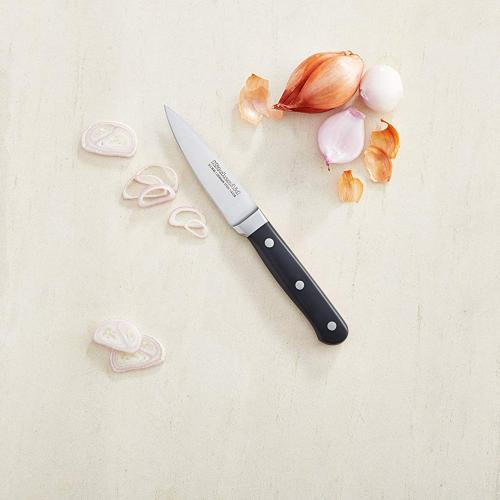
4. The serrated utility knife
The serrated utility knife is a good-to-have-around heavy-duty kitchen knife if you routinely cook with your partner or the chef’s knife is not available for whatever other reasons or you have really small hands and an 8” or 10” chef’s knife feels like a katana sword in your hands.
The serrated utility knife is a great plan B to a chef’s knife.
We recommend this knife by Mercer as it has so far exceeded all our expectations.
Mercer Culinary Millennia Utility Knife

Stepping up Your Kitchen Game
The knives in this section are not essential in a home kitchen, but if you want to take your skills to the next level, we highly recommend upgrading your gear with these beauties.
1. The Santoku knife
This one is a Japanese-style chef’s knife with an odd design and razor-sharp edge that does a fantastic job at slicing, dicing, and chopping vegetables.
So, if you usually have to deal with lots of veggies in the kitchen but want a reliable knife that won’t get dull after a few uses and gets the job done like a dream, get a Santoku.
This knife is better than most Western-style chef’s knives at slicing and dicing, which should be 90% of what most home cooks have to deal with in the kitchen.
But it is more expensive.
Here are our top picks:
Misono UX10 Santoku Kitchen Knife

This one is a knife many chefs have fallen irremediably in love with.
Global Santoku Hollow Ground

For a scary sharp Santoku knife, get a Global Santoku Hollow Ground knife and you won’t regret it.
2. The boning knife/ fillet knife
is designed to easily get the bones, stubborn fat, and skin off.
A boning knife is less flexible and thicker than a fillet knife, which is why we don’t recommend using a boning knife for filleting fish.
A fillet knife is thinner and more flexible than a boning knife because it was specially built for detailed precision cutting.
Also, most fillet knives’ blades curve slightly upward. So, if you want a professional tool for deboning meat or filleting fish, get one of these pups:
Dalstrong Boning Knife

Bubba Blade 7 Inch Fillet Knife

3. The Slicing knife aka the Slicer
This one is a long, flexible, and very sharp kitchen knife with a straight edge that should slice through cakes, roast meat, or ham gently without tearing up the interior. It has all the benefits of a serrated knife, but it is way more precise.
We recommend:
Dalstrong Slicing Knife Gladiator
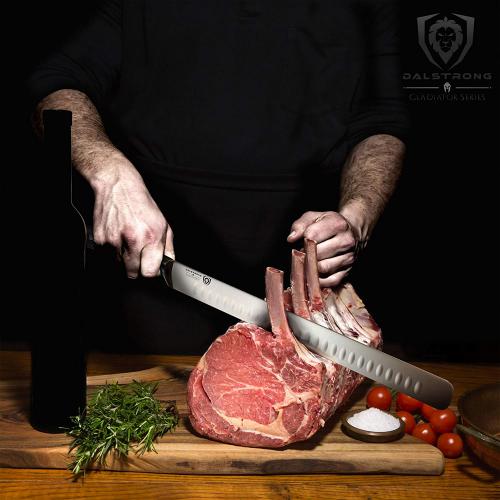
The Extras
These are knives and knife-like kitchen utensils that you could go without, yet without them, a kitchen is not complete.
1. The meat cleaver
We cannot claim this is a genuine kitchen knife, but it can successfully replace a knife in some scenarios.
A meat cleaver has a hatchet-like blade, duller edge, and a softer blade than a chef’s knife and it is usually used for cutting through tough cuts of meat, bones, and other dense foods.
It doesn’t need to be sharp to do its job as its cutting force relies on the cleaver’s heaviness and the cook’s force and swing.
One of the world’s most versatile meat cleavers is the Chinese cleaver, which can handle dense food while being sharp enough for paper-thin slicing.
We highly recommend:
Chinese cleaver by Winco

It has the ‘wow’ factor.
2. The steak knife
A quality set of steak knives is a must-have for cutting steaks properly. But please don’t get those serrated knives.
A classic non-serrated but razor-sharp steak knife set is all you need. Just take our word for it.
Wusthof WU9730 CLASSIC Six Piece Steak Set 6, Black

3. Kitchen shears
Many home cooks swear by the usefulness of a good pair of kitchen shears in a kitchen. Kitchen shears are great for cutting poultry apart and opening (stubborn) packaging, but they can also double as a nut cracker, and jar lid opener, and bottle opener.
We recommend getting a quality pair of kitchen shears, such as:
J.A. HENCKELS Kitchen Shears

Conclusion
Picking a knife or a set of kitchen knives is a very personal choice as most home cooks have made friends with some types of knives and it is hard to part ways with their favorites just because experts think it would be great to do so.
So, take our guide with a pinch of salt, and customize your kitchen arsenal as you feel it is best, but we would be happy to hear from you that some of the info here has helped you assemble your dream team of kitchen knives.
For further reading on each type of knife’s use and maintenance, we recommend these amazing books.
- Mastering Knife Skills: The Essential Guide to the Most Important Tools in Your Kitchen (with DVD) – Buy Now
- An Edge in the Kitchen: The Ultimate Guide to Kitchen Knives – Buy Now
- Knife Skills: An Illustrated Kitchen Guide to Using the Right Knife the Right Way. – Buy Now